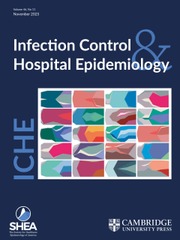Article contents
Implementation of Hospital-Based Candida auris Surveillance Screening Among At-Risk Patients
Published online by Cambridge University Press: 02 November 2020
Abstract
Background:Candida auris is an emerging multidrug-resistant pathogen associated with outbreaks in hospitals and skilled nursing facilities (SNFs). Patients with C. auris can have invasive disease or asymptomatic colonization. Because C. auris can be difficult to treat and eradicate in the environment, the CDC recommends using contact precautions and sporicidal agents during patient care. After C. auris was identified in a patient from an LA County SNF (SNF-X), our institution initiated surveillance screening on high-risk patients. Methods: Nurses identified patients residing at SNF-X on admission and contacted infection prevention. These patients were placed on contact or spore precautions. Bilateral axilla and inguinal folds were swabbed with an Eswab and sent for testing by a clinical laboratory-developed RT PCR assay, which can detect C. auris with high sensitivity and specificity with a rapid turnaround time (4–6 hours). This PCR assay was based on a commercial platform IntegratedCycler (Diasorin) and reagents from the same vendor. Environmental swabs from the index patient’s room were sent for PCR by HardyCHROM Candida agar (Hardy Diagnostics) before and after cleaning with OxyCideTM. PCR-positive samples were set up for culture. Results: In total, 27 patients from SNF-X were screened by PCR. Of these patients, 15 (55%) had a tracheostomy present on admission. Moreover, 26 swabs were negative; 1 was positive in the index patient (cycle threshold [Ct] value, 26). Clinical specimens from the index patient’s blood did not grow C. auris; the tracheostomy sample grew predominantly C. albicans which made identification of C. auris challenging by culture. However, investigational testing of this sample by PCR was positive (Ct value, 31). Environmental swabs collected from the patient room were obtained before and after cleaning (Table 1); all environmental cultures were negative at 5 days. Conclusions: Developing hospital-based, high-risk patient screening for C. auris is feasible and may be useful for controlling the spread of C. auris within the community. Further study is needed to determine the usefulness of PCR for environmental testing to assess the risk of nosocomial transmission of C. auris.
Funding: None
Disclosures: None
- Type
- Poster Presentations
- Information
- Copyright
- © 2020 by The Society for Healthcare Epidemiology of America. All rights reserved.
- 1
- Cited by





